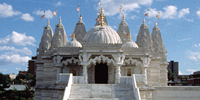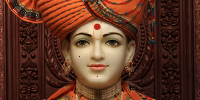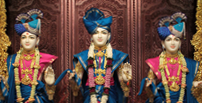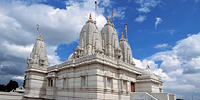About Hinduism
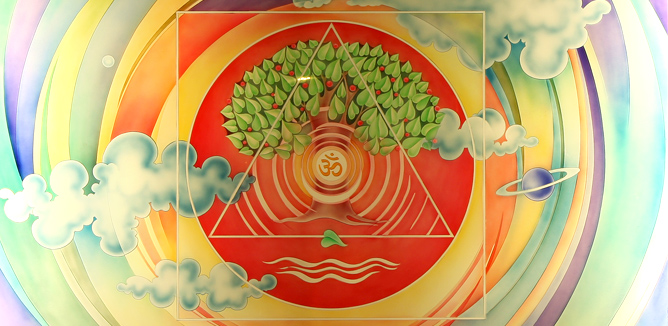
What is Hinduism?
- Hinduism is the oldest living religion in the world, and with almost a billion followers, it is also the world’s third largest religion. Originating from the vast Indian subcontinent, today it is spread across over 150 countries of the world.
- Hinduism, though, is not monolithic and has no one founder or central governing body. It embraces a ‘family’ of many diverse traditions, each with its own distinct theology, philosophy, rituals, code of practices and value system. This diversity makes Hinduism particularly hard to define in simple, precise terms. Nonetheless, like in any family, there are some common elements and unifying themes. These include accepting God or a Supreme Reality, atma (the soul), Dharma (the law of righteousness), karma (the law of cause and effect), the authority of the Vedas, and moksha (liberation).
For a more detailed answer, please click here.
Who is the founder of Hinduism?
- Hinduism, traditionally known as ‘Sanatan Dharma’ (the Way of Eternal Truth, or the Eternal Tradition), does not have a single human founder. As the term suggests, Hinduism is a religion based on eternal truths. Indeed, the sacred Vedas, which encapsulate this eternal wisdom, were divinely revealed by God to the ancient rishis (sages). Thus, Hindus believe that the true founder of Hinduism is God himself.
Who is a Hindu?
- Generally, a Hindu is a person who accepts the main beliefs of Hinduism and espouses the basic values and ideals of satya (truthfulness), saucha (purity), daya (compassion), ahimsa (non-violence), and brahmacharya (continence before marriage and fidelity thereafter), among others. These values are practiced in daily living in various ways. For example, for many Hindus, part of a compassionate lifestyle would include a strictly vegetarian diet, and a life of purity would mean abstaining from all intoxicating substances such as alcohol and tobacco.
- While remaining faithful to these values and other scriptural injunctions, a Hindu regulates his/her life according to the four main endeavours of Dharma (righteousness), Artha (wealth), Kama (aspirations) and Moksha (liberation). That is, each Hindu strives to lead a righteous life, earn an honest living, fulfil one’s aspirations through one’s earnings, and ultimately, be liberated from the perpetual cycle of births and deaths.
What are the main beliefs of Hinduism?
Despite the many diverse strands of Hinduism, most Hindus share some common beliefs. Here are just a few:
- There is one supreme, all-powerful loving God who is the ultimate creator, sustainer and destroyer of all things.
- God manifests on earth to revive Dharma and liberate souls.
- God is present in and can be worshipped through murtis (ritually-infused sacred images).
- The goal of human life is for the soul to be liberated from the perpetual cycle of births and deaths so as to remain eternally in the blissful service of God in his transcendental abode.
- The guidance and grace of a spiritually enlightened guru is essential for an aspirant seeking liberation.
For a more detailed answer, please click here.
Why are there so many Gods in Hinduism?
- Contrary to the common misconception, most Hindus believe in and worship one Supreme God. Yet in doing so, Hindus also acknowledge many other devtas, or divinities (often called simply ‘Gods’ or ‘gods’). These devtas perform various functions in the universe, but should not be confused with the one Supreme God who is the ultimate creator and sustainer of all things.
- One cause of confusion may be that Hindus of different languages, cultures and times assign different names and forms to their understanding of the one Supreme God. But many names for the one Supreme God does not mean that there are many Supreme Gods. This merely attests to the richness and magnanimity of Hinduism.
What is the atma?
- The atma, otherwise known as one’s soul, is the essence and life-force of an individual. It – Hindus believe the atma is neither male nor female – is distinct from one’s physical body and senses, and even one’s thoughts and feelings. Unlike the body, the soul is immortal and unchanging. It can take on a body of various forms (like wearing different clothes) as it passes through countless lives. The ultimate goal for each soul is to be liberated from this perpetual cycle of births and deaths and to earn an eternal place in God’s transcendental abode.
What is karma?
- Karma is the universal, unbiased and inescapable concept of ‘cause and effect’. It links each person to his or her actions and their corresponding fruits via God. Importantly, Hindus believe that God is the granter of the fruits of one’s deeds (whether good or bad), and so karma is not merely a mechanical law of action and reaction but a divinely ordered system which is infinitely fair. This reconciles the ideas of free will and fate.
What is reincarnation?
- Reincarnation – also called transmigration – is when, upon death of one physical body, the immortal soul is ‘reborn’ in (i.e. re-enters) the body of another life-form. This cyclic process of birth, death and rebirth continues until the soul eradicates its ignorance and can be granted moksha (ultimate liberation).
What is ahimsa?
- Ahimsa is the principle of non-violence (or non-injury) which discourages not only harmful actions but also abusive words and aggressive thoughts. Underlying this principle is a profound respect for all life and the belief that God permeates all beings, including plants and animals. This principle is the basis for a compassionate lifestyle, which includes a vegetarian diet.
- The Hindu espousal of ahimsa, however, does not imply absolute pacifism. In certain cases where it is one’s duty to protect oneself and others, self-defence is a legitimate practice.
What does the symbol of Aum mean?
- Aum is one of the most auspicious symbols of Hinduism. ‘Aum’ is also a sound, composed of three syllables – ‘A’, ‘U’ and ‘M’. It is the primordial sound of creation from which all other sounds are said to originate. It is also one of the most auspicious mantras in Hinduism, and is often chanted at the beginning and end of prayers as well as in meditation.
Why do Hindus use the Swastika?
- “Swastika” literally means ‘well-being’; “su” meaning ‘good’ and “asti” meaning ‘being’ combine with the suffix ‘ka’ to become “swastika”. It is symbolic of good fortune and prosperity, and so is often found in doorways of homes and shops and used as decoration during festivals and ceremonies such as weddings. With its arms pointing equally in all directions, the swastika also symbolises stability and balance.
- Although they appear similar, the Hindu swastika has no connection with the official emblem of the Nazi Party, also called the Swastika. This misappropriation of an ancient and sacred Hindu symbol can be an inadvertent cause of confusion and strife. However, Hindus have never harboured anti-Semitic sentiments, and have historically befriended the Jewish community.
Who composed the Hindu scriptures and when?
- The Vedas are the most ancient and most recognised of the Hindu scriptures. They are not considered to be composed by an individual in the traditional sense. Instead, Hindus believe that the eternal wisdom of the Vedas was divinely revealed to the ancient rishis (sages) by God himself. The rishis transmitted the teachings of the Vedas for generation upon generation using a precise oral tradition. These teachings were eventually committed to script by scholars many thousands of years ago. The sage Veda Vyas is said to have systematised or categorised the Vedas, though he is not their author. The Vedas are universally accepted as the world’s oldest religious writings, with some claiming their ideas to be more than 8,000 years old.
- Other Hindu scriptures, though more recent, have also passed through a similar process of divine revelation, oral transmission, and written composition.
